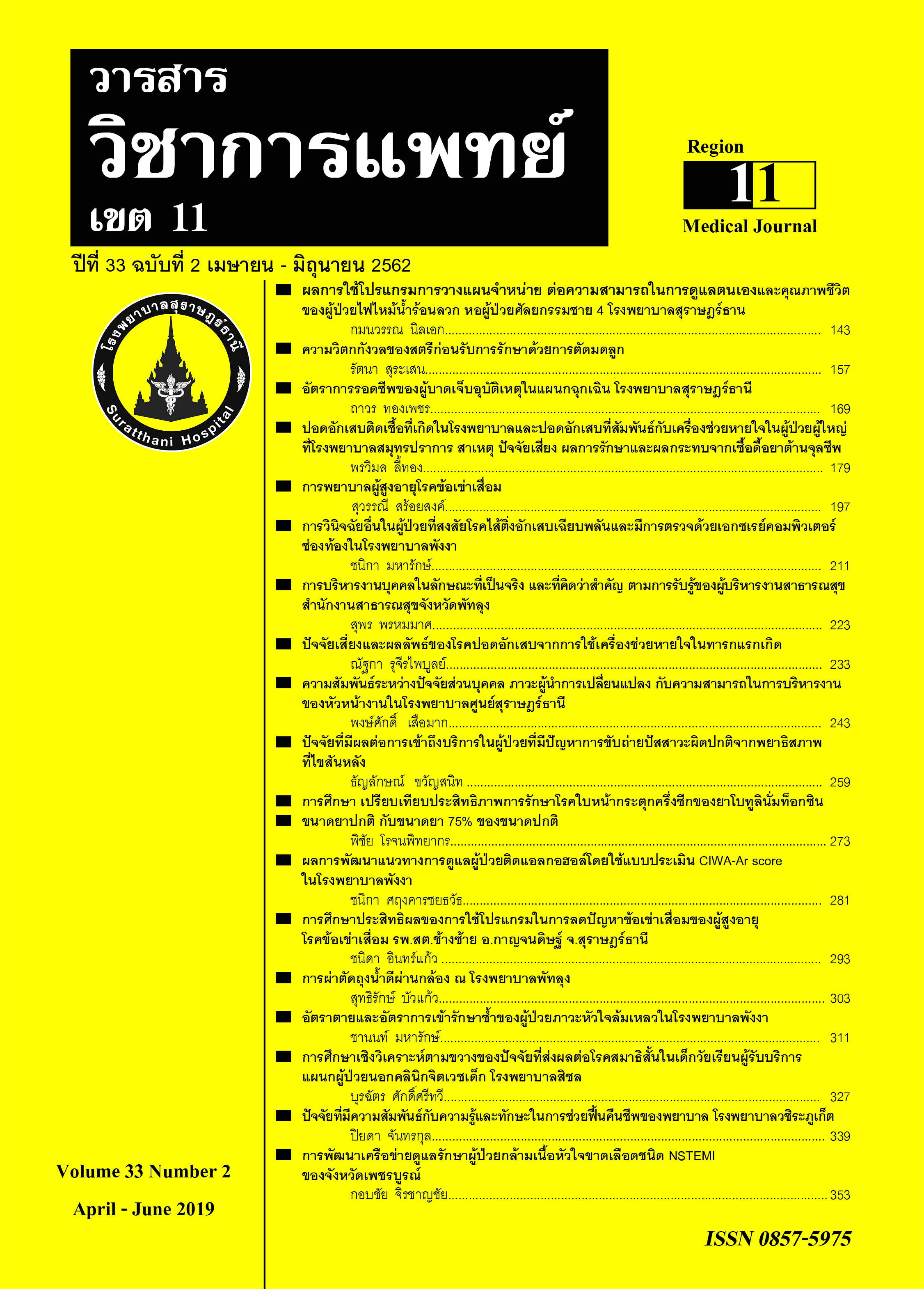The Effects of Discharge Planning Program for Burn Patients on Self-care ability and Quality of Life in Surgical 4 Department Suratthani Hospital
Keywords:
Discharge planning, Self- care ability, Quality of life, BurnAbstract
This research was a quasi-experimental research. The purpose of this study was to 1) compare self-care ability and quality of life among burn patients among those who received discharge planning programs and those who received regular nursing care. 2) compare self-care ability and quality of life among burn patients among those who received pre discharge planning programs and post discharge planning programs.and3) study the satisfaction level of the burn patients who received the discharge planning programs. Access to Surgical 4 department services between February – July, 2018 by at Suratthani Hospital. The experimental group selected 15 burn patients and 15 control subjects.Research Instrument were discharge planning programs follows D-METHOD. Data were collected using self-care ability questionnaire, quality of life for Thai people (WHOQOL-BREF-THAI), and satisfaction question
naire on discharge planning programs. Data were analyzed by percentage, mean, standard deviation, Mann-Whitney U testand Wilcoxon Sign-Rank test. The study found that:
1. Self-care ability and quality of life scores of burn patients who received the discharge planning programs were higher than those of Self-care ability and quality of life scores was statistically significant at the 0.01 level
2. Self-care ability and quality of life scores of burn patients who received the post discharge planning programs were higher than pre discharge planning programs was statistically significant at the 0.01 level
3. Satisfaction of the burn patients who received the discharge planning programs at the high level.
References
2 Qader AR. Burn mortality in Irag. Burns. 2012; 32: 772-75.
3 Chipp E, Milner CS, Blackburn AV. Sepsis in burns : A Review of current practice and future therapies. Ann PlasSurg. 2010 ;65(2): 228-36.
4 Suri MP, Dhingra VJ, Raibagkar SC, Mehta DR. Nutrition in burns: Need for an aggressive dynamic approach. Burns 2006; 32: 880-84.
5 สุธีร์ ธรรมิกบวร, การวางแผนจำหน่ายผู้ป่วย. การปรับกระบวนทัศน์. กรุงเทพฯ: บริษัท ธนาเพลส จำกัด; 2554.
6 สมบัติ ท้ายเรือคำ . ระเบียบวิจัยสำหรับมนุษยศาสตร์และสังคมศาสตร์.พิมพ์ครั้งที่ 2. กาฬสินธุ์: ประสานการพิมพ์; 2551.
7 Orem, D.E.Nursing Concepts of practice. (6thed.). St Louis, MO:Mosby; 2001.
8 Best,John.Research in Education. New Jersey:Prentice Hall, Inc;1977.
9 กรมสุขภาพจิต.เครื่องมือวัดคุณภาพชีวิตขององค์การอนามัยโลกชุดย่อ WHOQOL– BREF – THAI. [อินเตอร์เนต] [เข้าถึงเมื่อ15 มิถุนายน2561] เข้าถึงได้จาก: https://www.dmh.go.th/test/whoqol/)
10 Islam, S. S, Nambiar, A. M., Doyle, E. J. Velilla, A. M., Biswas, R. S., & Ducatman., A. M., et al. Epidemiology of work-related burn injury: Experience of a state-managed workers’ compensation system. Journal of Trauma-Injury Infection, and Critical Care, 2000; 49(6): 1045 – 1051.
11 อรพรรณ โตสิงห์. การพยาบาลผู้ป่วยแผลไฟไหม้ในระยะฉุกเฉินและระยะวิกฤต.[อินเตอร์เนต], 2550 [เข้าถึงเมื่อ 25 มิถุนายน2561] เข้าถึงได้จาก:from, http://
www.cnethai.org/nurse/article.php
12 Moi, A.L., Wentzel-Larsen, T., Salemark, L., &Hanestad, N. R. Long-term risk factors for impaired burn-specific health and unemployment in patients with thermal injury. Burn 2007; 33(1):37-45.
13 The National safety Council. Accident statistics. Office of Permanent Secretary, Office of the Prime Minister, Bangkok, Thailand; 1997.
14 Dyster-Aas, j., Kidal, M., &Willebrand, M. Return to work and health-related quality of life after burn injury. Journal of Rehabilitation Medicine 2007;
39(1):49–55.
15 ปรีดาภรณ์ สีปากดี.Discharge Planning For Burn Patients. Burn Care 2007. ชมรมแพทย์อุบัติเหตุไฟ ไหม้นํ้าร้อนลวกแห่งประเทศไทย. กรุงเทพฯ :กรุงเทพเวชสาร; 2550.
16 รัตนาภรณ์ แซ่ลิ้ม, นงลักษณ์ ว่องวิษณุพงศ์, สุดจิตไตรประคอง. ประสิทธิผลของโปรแกรมการวางแผนจำหน่ายต่อความรู้และพฤติกรรมการดูแลตนเองในผู้ป่วยโรคหลอดเลือดแดงส่วนปลายอุดตันในโรงพยาบาลสงขลานครินทร์.วารสารสภาการพยาบาล 2557; 29(2): 101-113.
17 ณัฏฐิกา แซ่แต้, สุดศิริ หิรัญชุนหะ, ขนิษฐา นาคะ. ผลของโปรแกรมการวางแผนจำหน่ายต่อความสามารถในการ จัดการอาการหอบเฉียบพลันของผู้ป่วยโรคหืดที่มารับบริการแผนกอุบัติเหตุฉุกเฉิน ภายใต้เหตุการณ์ความไม่สงบ ของพื้นที่ชายแดนภาคใต้. สงขลานครินทร์เวชสาร. 2552; 27(5): 359 – 368.
18 Orem, D.E. Nursing concepts of practice. (3rd ed.) New York: McGraw_Hill Book;1985.





